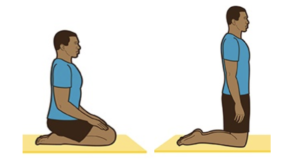Movement of the Month!
Brought to you by the Rebecca School Physical Therapy Department
March’s movement is…
Low to high kneel!

Brought to you by the Rebecca School Physical Therapy Department
March’s movement is…
Low to high kneel!

How to low kneel: In kneeling, the child sits back on feet. The arms can rest on lap or sides.
Transition from low kneel to high kneel: From low kneel, child squeezes glute muscles to bring hips up and forward into an upright position.
Why kneeling is important: Kneeling provides sensory integration via tactile input from the points of contact with the floor; improves body/spatial awareness; aids in the development of controlled mobility/stability; initiates weight acceptance through the pelvis; and activates & strengthens abdominal, back, and leg muscles. High kneeling is an important development step between crawling and standing.
Modifying kneeling: Hold knees together while putting pressure on the legs to stabilize; give tactile cues at hips to help facilitate the transition from low to high kneel; hold hands with the child to give extra support during the transition.
For an extra challenge: Try high kneel on a flat swing; try walking on knees in high kneel; try holding your hands above child’s head to encourage reaching up and lifting from low to high kneel; try sequencing Meatball, Log Roll, Cobra, Army Crawl, Crawl and then Kneeling!
High Kneel is also known as “Giraffe” or “Bunny Breaths” in our movement stories!
© Copyright 2022 Rebecca School. All Rights Reserved.
Learning Through Relationships
Leave a Reply